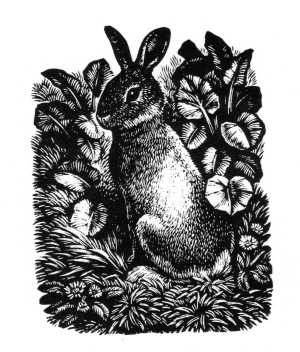Rabbit boiled with onions
This first recipe for rabbit comes from the eighteenth century via the estimable Jane Grigson; it sounds prosaic but is both foolproof and delicious. It is a springtime staple in the Editor’s house and works equally well with duck. If all you can find is a frozen bunny or bird, then this is an excellent recipe to select; freezing does not harm the final texture of the meat as it can when you roast it. Two servings.
 -a rabbit
-a rabbit
-mixed fresh herbs (marjoram, parsley, sage, thyme….)
-2-3 lb of big, whole, skinned onions
-salt and pepper
-4 Tablespoons unsalted butter
-4 Tablespoons heavy cream
-a pinch of mace or nutmeg (optional)
- Put the rabbit or duck and onions in a pot just big enough to hold them snugly along with the herbs, salt and pepper.
- “Bring to the boil and simmer until done--this will not take long, if the rabbit or duck is a young one.” The default estimate is just under an hour.
- Meanwhile, however, fish the onions out of the pot once they have softened, usually after about half an hour.
- Drain and chop the onions, then fry them until they turn a pale gold. Stir in the cream and a little of the stock in which the meat has simmered until you have the consistency you like, add the mace or nutmeg if you chose, check the seasoning and sauce the meat either before or after cutting it into servings depending on the presentation you prefer.
Notes:
- Mrs. Grigson served this dish with potatoes and spinach. We like it with peas too.
- If you cannot get fresh herbs use a generous teaspoonful of good dried thyme.
- The quotation in the recipe is from Jane Grigson’s English Food (London 1974) 224. As she also wrote on the same page, this is “[a] favourite eighteenth-century recipe, and a good one.”
- She warns that domesticated rabbit, the only variety available to most Americans, is “too insipid for this kind of treatment,” but we have not found that to be the case.
- Mrs. Grigson’s version of the recipe uses twice as much butter and none of the stock in making the sauce.
- Valentine Warner describes a much more involved recipe for Rabbit with Lettuce, Peas and Mint in What To Eat Now (London 2007). It is a good dish, although it can and should be improved with some straightforward modification. The preparation is generally good but the format and language of his recipe are difficult to follow, possibly because it is the transcription of a television program straining to sound both helpful to the novice and overly familiar to the viewer.
- Warner assumes that his reader (or viewer) is a culinary ignoramus so he offers some needlessly fatuous advice that makes it difficult to track the recipe while cooking. When dusting your rabbit with flour in a plastic bag, for example, “shake it around, making sure that the bag is strong, or as if by magic your rabbit will disappear in a puff of white--onto the floor.” Similarly, “[i]f you put it in a pot that is not hot enough it will sit there miserably,” and yet Warner never actually tells his reader to brown the rabbit over high heat. He could have used a better editor here, for after stating the obvious Warner flubs the lesson. (What 44)
- Nonetheless the marriage of these ingredients is both quintessentially English and harmonious if handled properly.

